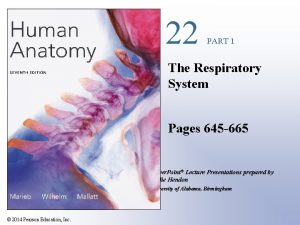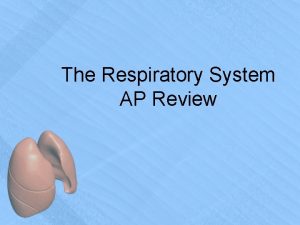Structure of the Respiratory system Respiratory system works

















- Slides: 17

Structure of the Respiratory system

Respiratory system works with the Cardiovascular system… Respiratory System: • Intakes oxygen • Releases carbon dioxide waste Circulatory system: • Transports gases in blood between lungs and cells

Structure of the RESPIRATORY system (RS)

The Importance of respiratory system • Cells need O 2 for work • CO 2 is produced as a waste product • Accumulation of excess CO 2 is toxic to cells and MUST be removed through the respiratory system

• Nasal cavity Respiratory Structures and their Functions – Space above and behind the nose – Made of cartilage and bone – Divided into 2 by a cartilaginous septum – Hairs within the nostrils filter out dust etc before air passes into two nasal cavities. – Designed to warm, moisten, and filter air before it passes to the nasopharynx • Pharynx – (throat) – A mucous layer – Funnel shaped muscular rube – Connects to larynx and esophagus and eustachian tubes – conducts food and air – exchanges air with Eustachian tube to equalize pressure

Respiratory Structures and Organs: Explained • Larynx – (voice box) – Connects the pharynx and the trachea. – Made of cartilage and muscle – contains vocal cords – Helps us to speak • Epiglottis ― flap of cartilage that covers trachea ― ensures food travels down the esophagus

Respiratory Structures and Organs: Explained • Trachea – (windpipe) – Tubular passageway (12 cm long 2 cm diameter) to carry air towards the lungs – C-shaped cartilage rings to keep it open – Divides at end into : right and left Bronchi larynx trachea bronchioles

Respiratory Structures and Organs: Explained • Bronchi: – Pair of tubes that branch from trachea and enter lungs – Have cartilage plates to keep them open – Lining is ciliated & secretes mucus • Each bronchus divides into: – – Lobar bronchi Segmental bronchi 23 branches in total Tree of bronchioles

Respiratory Structures and Organs: Explained • Bronchioles – – tiny tubes extend from the bronchi – lacking cartilage and cilia – possess smooth muscle bronchiole smooth muscle – They about 1 mm diameter – Terminate in clusters of alveoli

Respiratory Structures and Organs: Explained Lungs – Two cone shaped organs suspended in the pleural cavities – Surrounded by a pleural membrane – Made of elastic tissue – Divide into lobes – Right is larger as left has to accommodate the heart • This space is known as the cardiac notch

Respiratory Structures and Organs: Explained • Lungs - lobes –Left lung is divided into lobes. –Right lung has three lobes

• Visceral Pleura – Is the innermost of the two pleural membranes. It covers the surface of the lung • Pleural membrane – The lungs are surrounded by membranes known as pleura – These contain a cavity with fluid that lubricates the surfaces as the lungs expand contract. – Their main job is to prevent friction and keep the lungs airtight, • Pleural Fluid – The pleural membrane produces pleural fluid, which fills the space between the visceral and parietal pleura. This lubricating fluid allows the lungs to glide over one another

• Thoracic Cavity – the chamber of the chest that is protected by the thoracic wall. – separated from the abdominal cavity by the diaphragm

Respiratory Structures and Organs: Explained Alveoli • Around the bronchioles are 600 million alveoli in each lung. • Each one is in contact with a capillary • This is where exchange of O 2 and CO 2 takes place.

Alveoli • Cup shaped structures that resemble bunches of grapes • covered with SURFACTANT that keep them from collapsing • Provide a large surface area for gas exchange

Respirator y Muscles 1 -Intercostal muscles – External intercostals – Internal intercostals – Attachment is on the ribs 2 -Diaphragm – Dome shaped muscle at the bottom of the ribcage – Breathing in - Contracts – flattens, making chest cavity larger and creating a negative intrapleural pressure to draw air in.

Anatomy of the Respiratory system • Mouth & Nose. Passes through the Pharynx (back of throat). Passes through the Larynx (responsible for your voice production). • Air passes over the • • Air enters through the • Epiglottis (stops food going down our windpipe/trachea). Air enters the Trachea, membranous tube that delivers air to the lungs. • Trachea divides into 2 • 2 main Bronchi divide into 8 million bronchioles in each lung. • Around the Bronchioles you will find groups of air sacs called (600 million in each lung). Alveoli are the catalyst for gas exchange (O 2 and CO 2), as they are in contact with the capillaries. • Bronchi, one into each lung. Bronchioles, which further subdivide 23 times into Alveoli
 Conducting zone respiratory
Conducting zone respiratory Street works book
Street works book Circularory system
Circularory system Upper respiratory diagram
Upper respiratory diagram Upper respiratory tract anatomy
Upper respiratory tract anatomy Tiny air sacs at the end of the bronchioles
Tiny air sacs at the end of the bronchioles Circulatory system and respiratory system work together
Circulatory system and respiratory system work together Hình ảnh bộ gõ cơ thể búng tay
Hình ảnh bộ gõ cơ thể búng tay Frameset trong html5
Frameset trong html5 Bổ thể
Bổ thể Tỉ lệ cơ thể trẻ em
Tỉ lệ cơ thể trẻ em Voi kéo gỗ như thế nào
Voi kéo gỗ như thế nào Tư thế worms-breton
Tư thế worms-breton Chúa yêu trần thế alleluia
Chúa yêu trần thế alleluia Môn thể thao bắt đầu bằng chữ đua
Môn thể thao bắt đầu bằng chữ đua Thế nào là hệ số cao nhất
Thế nào là hệ số cao nhất Các châu lục và đại dương trên thế giới
Các châu lục và đại dương trên thế giới Công của trọng lực
Công của trọng lực

































